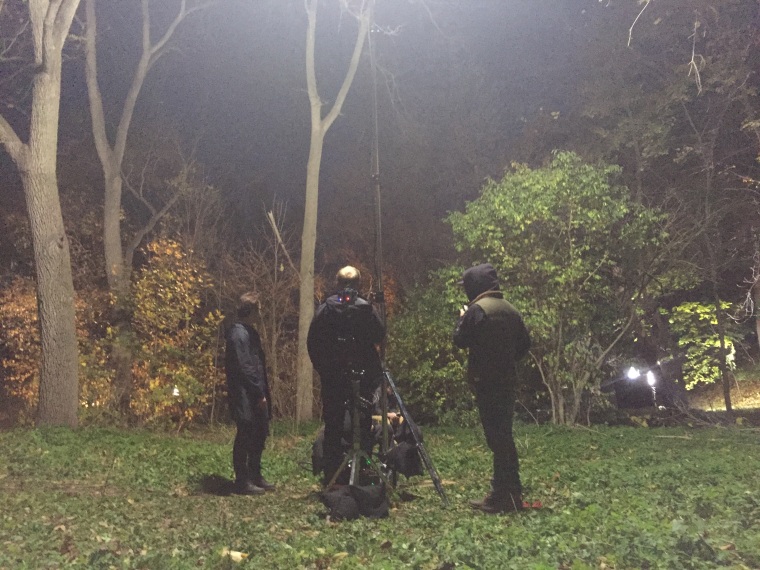This Is How Virtual Reality Will Change Entertainment And Possibly Everything Else
A Toronto production house talks about being on the ground floor of an exciting new industry.
In 2016, VR, or Virtual Reality, has transcended its status as a relic of cheesy ’90s cyberpunk films, and is approaching the cutting edge of entertainment—and perhaps more. Connor Illsley, 25, and Jon Riera, 26, are Combo Bravo, a Toronto-based production company specializing in VR and 360 video. They are part of small creative communities worldwide pushing the boundaries of platforms like the Oculus Rift and HTC Vive. If the technology takes off as intended, their work will be the basis of a massive cultural shift. “The world’s reintroduction, to VR is almost as immense as when sound got locked to picture in films,” Riera said, this week in Toronto, “because it’s a completely new way of experiencing a medium.”
From June 24 to 26, The FADER in collaboration with the Toronto International Film Festival is presenting POP01, a three-day show of some of the most intriguing and creative pieces of VR art. One of those works, Jazz Cartier’s “Red Alert / 100 Roses” video, was produced over five months by Illsley and Riera, with a local music video production company called Mad Ruk. We talked with them about the excitement and frustrations of being a creative startup in an industry Riera describes as “the wild, wild west, [where] everybody’s creating the rule book as they go along.” Combo Bravo will also discuss their work on the Jazz Cartier video and more at TIFF's POPx panel, hosted by The FADER’s Joseph Patel, on Saturday, June 25.
 Photo via Combo Bravo
Photo via Combo Bravo
What’re the differences between VR and 360?
CONNOR ILLSLEY: It’s a highly contested point in the [VR] community. A lot of people think of virtual reality strictly as something that you’re inside and controlling. A lot of people think saying that a 360 video is virtual reality isn’t doing the concept enough justice. So you’ve got purists and snobs, but one of the coolest parts of making 360 content is the community. There are so few people doing it; it’s really easy to identify who’s doing good work. We’re members of a lot of forums, which are a big help if we run into technical problems because sometimes we don't know if we’re the first people to ever have to solve that specific problem, because everything’s so new.
If VR headsets do become mainstream, how do you think immersive technology will affect our relationship with reality?
ILLSLEY: People are still trying to figure that out. I love telling stories in VR, but I’m interested to see its applications outside of entertainment. Even now I’m reading about PTSD therapy and headsets; trying to treat depression, anxiety, and disassociation therapy with VR. It’s sort of backwards, like, how the army created radio and then it was adapted to entertainment. It’s cool that something is coming from the entertainment sector and spreading outwards.
JON RIERA: As VR evolves, it’ll either be something that’s embraced as an escape similar to television and movies, or it’ll be taboo and become something a certain niche appreciates. But there’s always going to be the question of, when is it too much?, all this increased interactivity that we’re craving more and more.
“Sometimes we don’t know if we’re the first people to ever have to solve that specific problem, because everything’s so new.”
 Photo via Combo Bravo
Photo via Combo Bravo
Above: an improvised 360 drone rig for aerial shots.
What will VR look like 10 years from now?
ILLSLEY: Today I see a lot of people who, in certain ways, want to do normal filmmaking in 360, which I think is sort of short-sighted. What I’m excited for is people coming up with new ways to tell stories in the new format that audiences respond to. That’s what we wanted to do with Jazz’s video: not just having something cool and putting a camera beside it, but coming up with the craziest scenario we could put Jazz in, put a crazy world around him, and figuring out the best seat in the house for that.
What are some challenges and limitations specific to VR production?
RIERA: A lot of it is backwards to forwards: you have to think about the final part before the beginning. Every video that we’ve done, we’ve tested the entire thing out with ourselves as the talent, coordinating the [on-screen movement]. Since it’s 360, unless you’re doing some kind of trick, you can’t hide anything from the camera. Everything needs to be practical. You can’t tailor it as much as traditional cinema.
ILLSLEY: Most of the issues we had to think about early on revolved around creating new accessories on existing tech to achieve certain things. Like, what we shot Jazz on was all GoPro-based rigs, 10 of those on a ball. Then you take them to post-production and try to make them seamless. So even inventing something to power all 10 GoPros simultaneously instead of changing tiny batteries, or flying in on a drone to get the aerial shots then editing it out, all of these things had to be developed and tested along the way. I’m excited for that technology and the software to catch up to VR and what creators need.
 Photo via Combo Bravo
Photo via Combo Bravo
Above: Jon Riera and Connor Illsley.